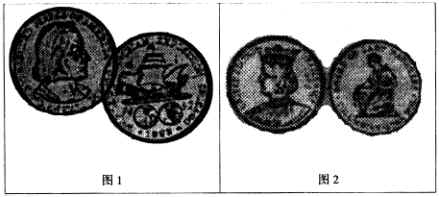 设为首页
设为首页
 加入收藏
加入收藏
COINS
One can bank on the
fact that most coins derive from Latin
words, and are named after people, places,
or things.
Even the word coin, translates from
the Latin "cuneus," meaning
wedge, and was thusly named because early
coins ressembled the wedges the dies used
to coin coins. Our cent, from the Latin
"centum," meaning one hundred,
our dime, from the Latin "decimus,"
meaning tenth, and the French franc, from
the Latin "Franconium Rex,"
meaning King of the Franks, are all examples
of the naming of money, the root of all
evil, which translates from the Latin
word "mona," meaning to warn!
On to a more weighty manner in which
people named coins, that being physical
weight. The English pound, translates
from the Latin "pondo," meaning
pound, or, to get more heavily into detail,
from the Latin "libra pondo,"
meaning a pound of weight. This method
of naming coins weighed heavily in naming
of the Spanish peso and of the Italian
lira.
A sense of fairness dictates that some
coins bear the names of the metals of
which they are composed. Thus, our nickel
is made of nickel. Location, not Latin,
sometimes figures prominently into the
naming of sum (oops!), some coins. Our
very own dollar, not always in paper form,
originally hailed from the silver mines
of Bohemia, where Bohemians extracted
silver for the coins, and minted them
in the town of Joachimsthal. Realizing
that the coin they termed the Joachimsthaler,
short of lacking in creativity, was rather
lengthy, our Bohemian friends lost the
head of the name, and kept the tail, with
the end result being the thaler. The thaler
eventually lost its lisp, and became our
dollar.
Many countries used their word for crown,
for example, crown, sovereign, krone,
krun, krone, corona (not the beer), to
demonstrate that some crown authority
initially granted permission to mint them.
Other countries named coins in honor of
their heros, such as the Panamanian balboa,
after the explorer Balboa, the Venezuelan
bolivar, after one of it's national heros,
and the Peruvian sol, also not a beer,
but the Spanish word for sun, after this
ancient Incan object of worship.
人们会发现这一事实,大多数硬币的名称是由拉丁文派生出来的,它们是以人名,地名或物名来命名的。
甚至“coin”(硬币)一词,是从拉丁文“cuneus”翻译过来的,意思是“楔子”。之所以称之为“楔子”,是由于早期的硬币与用来铸造硬币的楔形模具很相似。我们的美分“cent”一词,来自拉丁文“centum”,意思是“一百”。“角”(dime)一词来自拉丁文“decimus”,意为“第十”。法国的货币法郎“franc”一词来自拉丁文“Franconium
Rex”,意为“法兰克人之王”。所有这些都是给钱币,人们所说的万恶之源,命名的例子,而钱(MONEY)一词也是由拉丁文“mona”演绎而来的,意为“警告”!
后来,人们又按其重量命名硬币,即实物的重量。英镑是由拉丁字“pondo”演绎而来的,意思是“帮”,从重量角度看更具体一点说是来自拉丁文“libra
pondo”,意为“一磅重”。这种从重量上命名硬币的方法,对西班牙货币比索及意大利货币里拉来说显得特别重要。
还有一些硬币直接以铸造它们的金属名称而得名,这样比较一目了然。例如,我们的五分镍币是以镍制造的。有时我们以产地,而并非拉丁文,来形象地表明某些硬币的面值。我们的美元
Dollar ,并不一直都是以纸币形式出现的,它起源于波希米亚的银矿。波希米亚人从硬币中提炼出银,然后在Joachimsthal镇制成硬币。起初,他们称这种硬币为Joachimsthaler,后来,他们认识到这一名称缺乏创新,而且太长,因此我们的波希米亚朋友就把这个字去掉头部,保留尾部,结果就成了“thaler”这个样子。“thaler”一词最终失去了咬舌音“th(A/o)”,而成为了我们今天的“dollar”一词。
许多国家都用“克朗”(crown)一词作硬币名称,如crown(克朗),sovereign(英国的一种金镑硬币,现在已不用),krone(丹麦,挪威,克朗),kyun,corona(花冠,非啤酒名)等。之所以用“crown”一词,是因为crown意为“皇冠”,指一开始由国王授予的造币权。还有一些国家则以其英雄的名字来命名硬币。如巴拿马的巴尔波则是以探险家巴尔波(Balboa)命名的;委内瑞拉波利瓦则是以这个国家的一位民族英雄名字命名的。秘鲁的索尔,也不是什么啤酒名,而是西班牙语的“太阳”,是古代印家人崇拜的对象。
美国最早的纪念币
美国建国于1776年,一个相对说来是比较年轻的国家。美国统一的正式硬币始于1792年。
美洲大陆是1492年由意大利人哥伦布发现的,美国最早的纪念币与此有关。
1892年,美国为纪念哥伦布发现新大陆400周年,在芝加哥(当时美国铁路中心)举办了哥伦布博览会(Columbian
Exposition)。会上发行 l/2美元纪念银币一枚(图 1)。它是美国发行的第一枚纪念币。由著名设计师巴伯(C·E·Barber)设计了币正面哥伦布头像;另一著名设计师摩根(
G· T· Morgan)设计了币背面,正中为哥伦布发现新大陆时的旗舰圣马利亚号(Santa
Maria),舰下为两个半球,象征新旧大陆。纪念币在1892、1893年共发行了250万枚,在博览会上售价1美元。未售出部分进入流通。大约有200枚精制币。现普通币售价100~500美元,精制币4500~5000美元。
与此同时哥伦比亚博览会妇女经理委员会提出了发行纪念币的要求,后经批准发行1/4美元伊莎贝拉女王纪念银币一枚(图2)亦由巴伯设计,币正面为伊莎贝拉头像,反面为手持纺锭和纺锤的半蹲妇女。当时售价亦为1美元,发行量2.5万枚。目前本流通币价格约500美元。

伊莎贝拉(Isabella,1451-1504年)系西班牙卡斯蒂利亚和阿拉贡女王,她与丈夫阿拉贡国王贾迪南德实行联合统治。对于她的一生褒贬不一,但她曾与费迪南德国王共同支持哥伦布的远洋探险,从而促成了新大陆的发现。
1992年是哥伦布发现新大陆500周年纪念。发行哥伦布纪念币的国家就多如雨后春笋了。